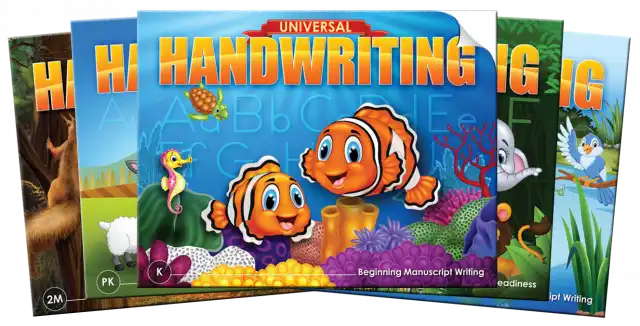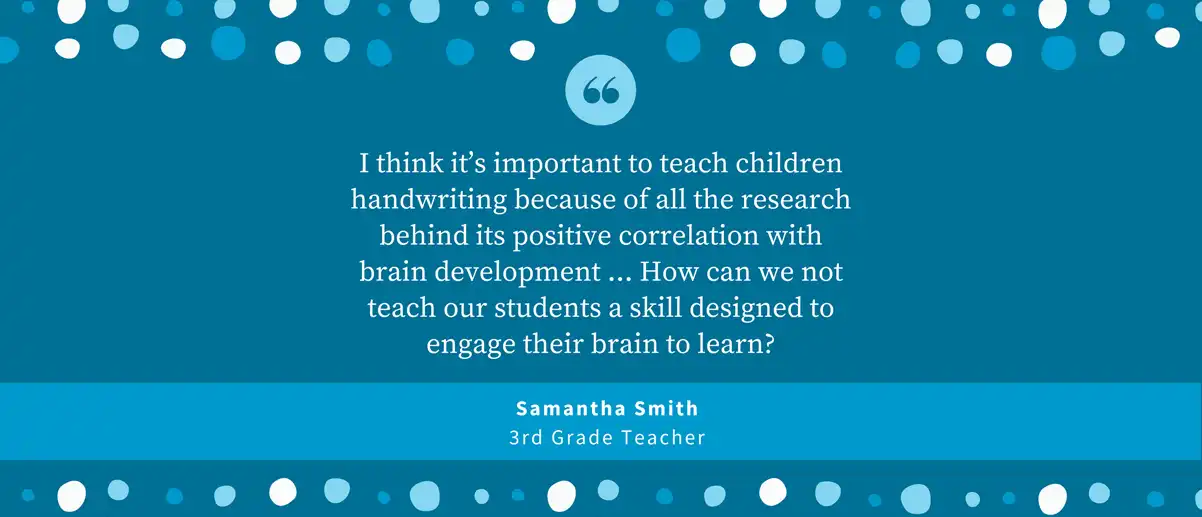
Reading and Writing by Hand: How Handwriting Builds Literacy Skills
When we hear the word “literacy,” we often immediately think of reading. However, there is another component of literacy that deserves equal attention: handwriting.
The Merriam-Webster Dictionary defines “literate” as “able to read and write.” Literacy development is not just about learning to read; it’s also about learning to write. Direct handwriting instruction builds a variety of skills that are used for both reading and writing by hand.
Let’s take a look at how these two skills are intertwined.
The Link Between Reading & Writing by Hand

First, it’s important to note that handwriting is beneficial in its own right. Like reading, handwriting is also an important learning tool. The physical act of writing by hand helps us remember and comprehend information (which, interestingly, does not happen when we type).
Even in our digital world, elementary students still complete approximately 90% of their assignments and tests by hand. This fact alone highlights the importance of teaching students handwriting.
In addition to these benefits, research shows that writing by hand reinforces reading development in several ways.
Handwriting Builds Letter Knowledge
As students learn to write manuscript letters, this process reinforces reading development by building letter knowledge. According to the National Reading Panel, letter knowledge is one of the two “strongest predictors of how well children will succeed in learning to read.”
Handwriting instruction teaches students more than just the mechanics of letter formation. It reinforces letter recognition and helps them learn the names of the letters and letter-sound associations. It also helps students understand that letters can look different (natural variations in handwriting as well as different fonts) and learn to recognize general identifying characteristics of letters.
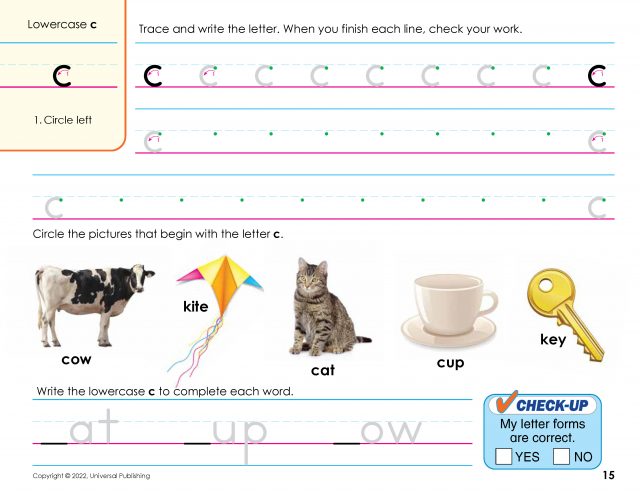
Another study found that “the motor experience of manually creating letterforms helps children discriminate the essential properties of each letter, which leads to more accurate representations bolstering both skilled letter recognition and later reading fluency.”
Additionally, a study published in the Journal of Educational Research showed that students participating in two different methods of writing instruction (writing workshops and interactive writing) showed significant improvement in phonological awareness, alphabet knowledge, and word reading.
Handwriting Activates Literacy Regions of the Brain
At Indiana University, Dr. Karin Harman James studied how writing by hand affects brain activity. Using functional Magnetic Resonance Imaging (fMRI) scans, Dr. James discovered that when children write by hand, areas of the brain associated with literacy light up with adult-level activity.
This research shows how the physical act of writing by hand activates areas of the brain associated with reading, language, and memory. When those areas are activated, particularly at the same time, it reinforces both reading and writing skill development.
Handwriting Reinforces Print Awareness
As students learn to write letters and words, they are also building print awareness. Handwriting instruction and practice help students exercise the visual tracking skills utilized for reading, such as understanding that we read from left to right and top to bottom. As students begin to write sentences, they learn to capitalize the first word in a sentence, apply correct spacing between words, and include punctuation.
Learning to write by hand also teaches students to focus on a task. To correctly write a letter, students must learn the steps involved in forming the letter and then recall those steps as they practice writing the letter.
Handwriting Supports Spelling & Vocabulary
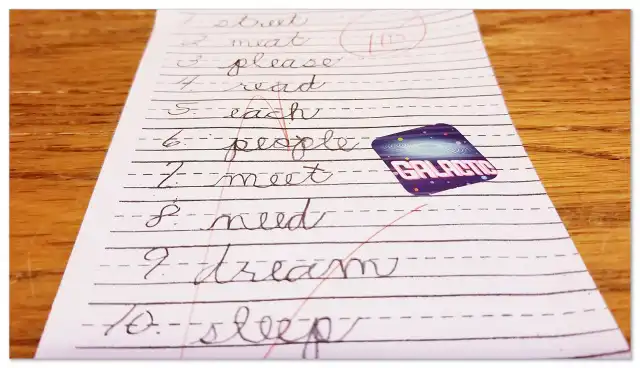
Writing by hand also reinforces spelling skills. In this study, first-grade students who wrote their spelling words by hand scored higher on spelling tests than those who typed the spelling words. Similarly, a 1998 study revealed that second-grade students writing highly predictable words scored higher than those practicing the words on a computer.
Handwriting can also support vocabulary acquisition, which in turn boosts reading fluency and comprehension. As previously mentioned, writing by hand helps us retain information, including word meanings. When students write words and definitions, it helps them learn what the words mean.
Cursive writing in particular can assist with spelling and vocabulary skills. Cursive writing uses both the left and right hemispheres of the brain, which research shows can enhance memory and language function. Because the letters are connected, the brain “sees” words as whole units rather than as individual letters. The connected letters are also helpful for students who have difficulty recognizing where words begin and end.
4 Strategies to Develop Handwriting Skills
Clearly, handwriting is an important component of literacy development. To help your students reap all of the benefits of writing by hand, here are three strategies to help develop handwriting skills and increase literacy.
1. Always begin with the basic strokes.

Students need to learn to write 52 letters (26 uppercase letters and 26 lowercase letters), as well as ten numerals. Asking them to learn to “draw” 62 shapes sounds like a daunting task. That’s why we recommend always beginning handwriting instruction with the basic strokes. In manuscript, the basic strokes include vertical lines, horizontal lines, diagonal lines, and circles. Young students are already familiar with these shapes; if they can draw a good stick figure, they will have no trouble learning the manuscript basic strokes. In cursive, there are four basic strokes: slant, undercurve, downcurve, and overcurve.
Once students know the basic strokes, they can combine those strokes to form letters and numerals. This is so much easier than just looking at a “shape” (letter) and trying to figure out how to form it! Teaching letter formation based on these components will also help students recognize letters in different fonts and handwriting.
2. Provide direct handwriting instruction.

Handwriting is a skill that must be taught. When handwriting practice is assigned with no prior instruction, students may form letters incorrectly and develop bad handwriting habits that are difficult to remedy later. Practice makes permanent – but not necessarily perfect! Direct instruction ensures that students know how to form the letter, so they have a clear understanding of what to do when they pick up a pencil to practice.
To make handwriting practice most effective, students should first thoroughly understand how to form the letter. Modeling correct letter formation for students is so important! (We recommend using AlphamationPlus for modeling manuscript and cursive letter formation.) Explain which basic strokes are used in the letter and in what order, and how the letter should be positioned on the writing lines. Provide a model of the letter with directional arrows so that students have a visual for reference.
3. Encourage Self-Evaluation.
As students practice writing, it’s important for them to periodically pause and evaluate their work. This allows students to identify any areas they need to work on, so they know what to adjust as they continue to practice.
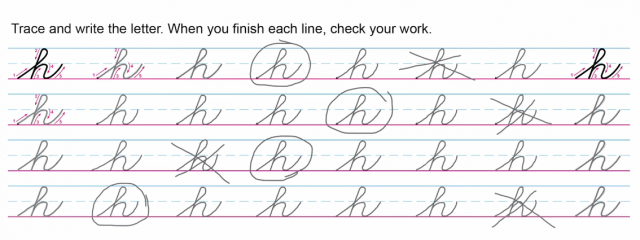
After each line of letter practice, students should stop and self-evaluate their writing before moving on to the next line of practice. Ask them to circle their best letter and put an X under the letter that needs the most improvement. Ask them why they selected those letters. What makes their best letter the best? What don’t they like about the letter they put an X under? Now, when students continue with the next line of practice, they’ll know what to work on to improve their handwriting.
4. Create a print-rich environment.
Provide letter models in your classroom for students to reference as they write throughout the day. This is particularly important when students are first learning how to write manuscript or cursive letters; they may need that reminder of how to form a letter. Handwriting support materials like alphabet wall strips, alphabet desk strips, and alphabet wall posters will reinforce legible handwriting and also build letter knowledge and print awareness.
Word walls, classroom labels (window, door, books, etc.), magnetic letters, daily schedules and assignments, and displays of student work also help to create a print-rich environment in your classroom.
Reading and writing are essential skills for young students to learn. They’ll use these skills to help them learn in every subject. Teaching your students to write by hand will reinforce overall literacy development and provide them with a learning tool they’ll use for years to come!

